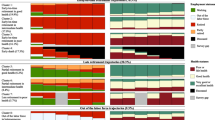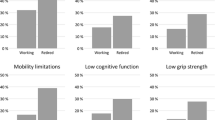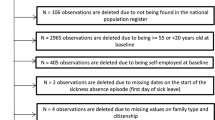Abstract
Like many OECD countries, Germany is currently facing a shortage of long-term care (LTC) workers. This situation is concerning in the context of the ageing of the German population. A potential reason why Germany fails to recruit and retain LTC workers is that LTC jobs are particularly demanding (physical and psychological strain) which may be harmful to health. However, there is a lack of empirical evidence demonstrating this effect. This article fills the gap in the literature by exploring to what extent LTC jobs reduce workers’ health over time. We estimate a dynamic panel data model on the German Socio-Economic Panel (v.35; 1984–2018), which allows adressing selection issues into occupations. Our paper provides innovative findings on the impact of LTC occupations on workers’ health. We confirm that LTC jobs have a negative impact on self-reported health. Our results have strong policy implications: we emphasize the need to provide sufficient assistance to LTC workers, who are at risk of facing more health issues than other workers. This issue is key to increase the attractiveness of LTC jobs and reduce turnover in the LTC workforce.

Similar content being viewed by others
Notes
The OECD’s definition excludes the hospital sector of LTC jobs. Nevertheless, distinguishing between the hospital and residential/home sectors is only possible after 2012 using the revised NACE classification (see Table 6). To include as little noise as possible in our estimation, we include the hospital sector among LTC jobs before 2013 but differentiate the two sectors after this year. Panel C corrects this approach.
Duration (or job tenure) is defined here as the number of waves/years observed in the job.
Few immigrants (2% of our sub-sample) acquired German citizenship over the period considered. We only consider here responses in the first wave.
For parsimony, we comment on the results only for panel B, but the conclusions hold for panel A.
References
Campbell, J.C., Ikegami, N., Gibson, M.J.: Lessons from public long-term care insurance in Germany and Japan. Health Affairs 29(1), 87–95 (2010)
Harrington, C.A., Geraedts, M., Heller, G.V.: Germany’s long term care insurance model: lessons for the United States. J. Public Health Policy 23(1), 44–65 (2002)
Geyer, J., Korfhage, T.: Labor supply effects of long-term care reform in Germany. Health Econ. 27(9), 1328–1339 (2018)
Bakx, P., De Meijer, C., Schut, F., Van Doorslaer, E.: Going formal or informal, who cares? the influence of public long-term care insurance. Health Econ. 24(6), 631–643 (2015)
Nadash, P., Doty, P., Mahoney, K.J., Von Schwanenflugel, M.: European long-term care programs: lessons for community living assistance services and supports? Health Serv. Res. 47(1pt1), 309–328 (2012)
OECD: Health at a glance 2019. OECD publishing, Paris (2019)
Grabowski, D.: Long-term care—encyclopedia of health economics. Elsevier, Amsterdam (2014)
Kuhlmann, E., Larsen, C.: Long-term care in europe challenges and strategies in nursing staff management. Bundesgesundheitsblatt, Gesundheitsforschung, Gesundheitsschutz 56(8), 1064–1071 (2013)
Kliner, K., Rennert, D., Richter, M.: Gesundheit und Arbeit-Blickpunkt Gesundheitswesen: BKK Gesundheitsatlas 2017. MWV Medizinisch Wissenschaftliche Verlagsgesellschaft (2017)
Franz, S., Zeh, A., Schablon, A., Kuhnert, S., Nienhaus, A.: Aggression and violence against health care workers in Germany-a cross sectional retrospective survey. BMC Health Serv. Res. 10(1), 51 (2010)
Hanson, G.C., Perrin, N.A., Moss, H., Laharnar, N., Glass, N.: Workplace violence against homecare workers and its relationship with workers health outcomes: a cross-sectional study. BMC Public Health 15(1), 11 (2015)
Grossman, M.: On the concept of health capital and the demand for health. J. Polit. Econ. 80(2), 223–255 (1972)
OECD: Who Cares? Attracting and retaining care workers for the elderly. OECD publishing, Paris. (2020). https://doi.org/10.1787/92c0ef68-en
Liang, Y.W., Hsieh, Y., Lin, Y.H., Chen, W.Y.: The impact of job stressors on health-related quality of life of nursing assistants in long-term care settings. Geriatr. Nurs. 35(2), 114–119 (2014)
Joyce, K., Pabayo, R., Critchley, J.A., Bambra, C.: Flexible working conditions and their effects on employee health and wellbeing. Cochrane Database Syst. Rev. (2010). https://doi.org/10.1002/14651858.CD008009.pub2
Robone, S., Jones, A.M., Rice, N.: Contractual conditions, working conditions and their impact on health and well-being. Eur. J. Health Econ. 12(5), 429–444 (2011)
Ravesteijn, B., Hv, Kippersluis, Ev, Doorslaer: The wear and tear on health: what is the role of occupation? Health Econ. 27(2), e69–e86 (2018)
Franks, P., Gold, M.R., Fiscella, K.: Sociodemographics, self-rated health, and mortality in the us. Soc. Sci. Med. 56(12), 2505–2514 (2003)
Idler, E.L., Benyamini, Y.: Self-rated health and mortality: a review of twenty-seven community studies. J. Health Soc. Behav. 38, 21–37 (1997)
McCallum, J., Shadbolt, B., Wang, D.: Self-rated health and survival: a 7-year follow-up study of Australian elderly. Am. J. Public Health 84(7), 1100–1105 (1994)
Van Beveren, J.: Does health care for knowledge management? J. Knowl. Manage. (2003). https://doi.org/10.1108/13673270310463644
Wagstaff, A.: The demand for health: an empirical reformulation of the grossman model. Health Econ. 2(2), 189–198 (1993)
Nickell, S.: Biases in dynamic models with fixed effects. Econometrica J. Econometr. Soc. 49, 1417–1426 (1981)
Bond, S.R.: Dynamic panel data models: a guide to micro data methods and practice. Portuguese Econ. J. 1(2), 141–162 (2002)
Angrist, J.D., Pischke, J.S.: Mostly harmless econometrics: an empiricist’s companion. Princeton University Press, Princeton (2008)
Mundlak, Y.: On the pooling of time series and cross section data. Econometrica J. Econometr. Soc. 46, 69–85 (1978)
Wooldridge, J.M.: Correlated random effects models with unbalanced panels. J Econometrics. 211 (1), 137–150 (2019)
Dauth, C., Lang, J.: Can the unemployed be trained to care for the elderly? the effects of subsidized training in elderly care. Health Econ. 28(4), 543–555 (2019)
Pirani, E., Salvini, S.: Is temporary employment damaging to health? a longitudinal study on Italian workers. Soc. Sci. Med. 124, 121–131 (2015)
Columbo, et al.: Help wanted? Providing and paying for long-term care. OECD Publishing (2011)
Baughman, R.A., Smith, K.E.: Labor mobility of the direct care workforce: implications for the provision of long-term care. Health Econ. 21(12), 1402–1415 (2012)
Rapp, T., Sicsic, J.: The contribution of the immigrant population to the us long-term care workforce. Soc. Sci. Med. 263, 113305 (2020)
Author information
Authors and Affiliations
Corresponding author
Appendices
Appendix A
Detail description of similar jobs
Appendix B
Self-perceived health for panels A, B and C
See Fig. 2.
Self-perceived health distributions of panels A, B and C. The two top graphs (panel A) show the self-perceived health distributions for our group of interest (left chart), composed of long-term care and similar workers, and our first comparison group (right chart), composed of all remaining workers. The middle graphs (panel B) reproduce the distributions for long-term care jobs (left chart) and for similar jobs (right chart). The bottom graphs (panel C) describe the distributions for the LTC workers (left chart) and for personal care workers and nurses practising in hospital settings (right chart). Source: GSOEP, v35 (1995–2018). Skewness (S) and Kurtosis (K) descriptives, with Kolmogorov-Smirnov (KS) tests: Panel A: (a): S = − .80; K= 3.42 ; KS test = 0.0940*** (b): S = − .77; K=3.31 ; KS test = 0.0881***; Panel B: (c): S = − .83; K= 3.46 ; KS test = 0.0832*** (d): S = − .75; K = 3.25 ; KS test = 0.0901***; Panel C: (e): S= − .80; K = 3.35 ; KS test = 0.0833*** - (f): S = − .57; K = 2.94 ; KS test = 0.0787***
Appendix C
Sensitivity analyses
Appendix D
Stratified analyses—Panel A
Appendix E
Stratified analyses—Panel B
See Tables 15, 16, 17, and 18.
Rights and permissions
About this article
Cite this article
Rapp, T., Ronchetti, J. & Sicsic, J. Are long-term care jobs harmful? Evidence from Germany. Eur J Health Econ 22, 749–771 (2021). https://doi.org/10.1007/s10198-021-01288-y
Received:
Accepted:
Published:
Issue Date:
DOI: https://doi.org/10.1007/s10198-021-01288-y





